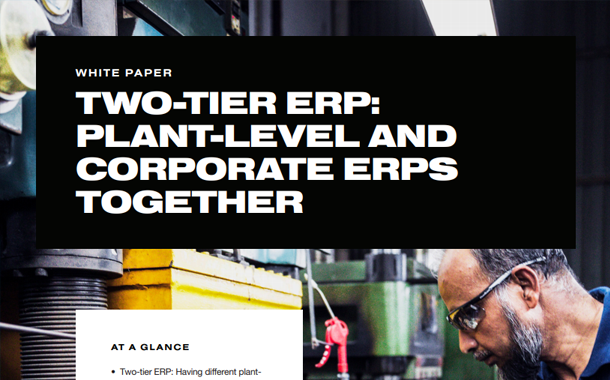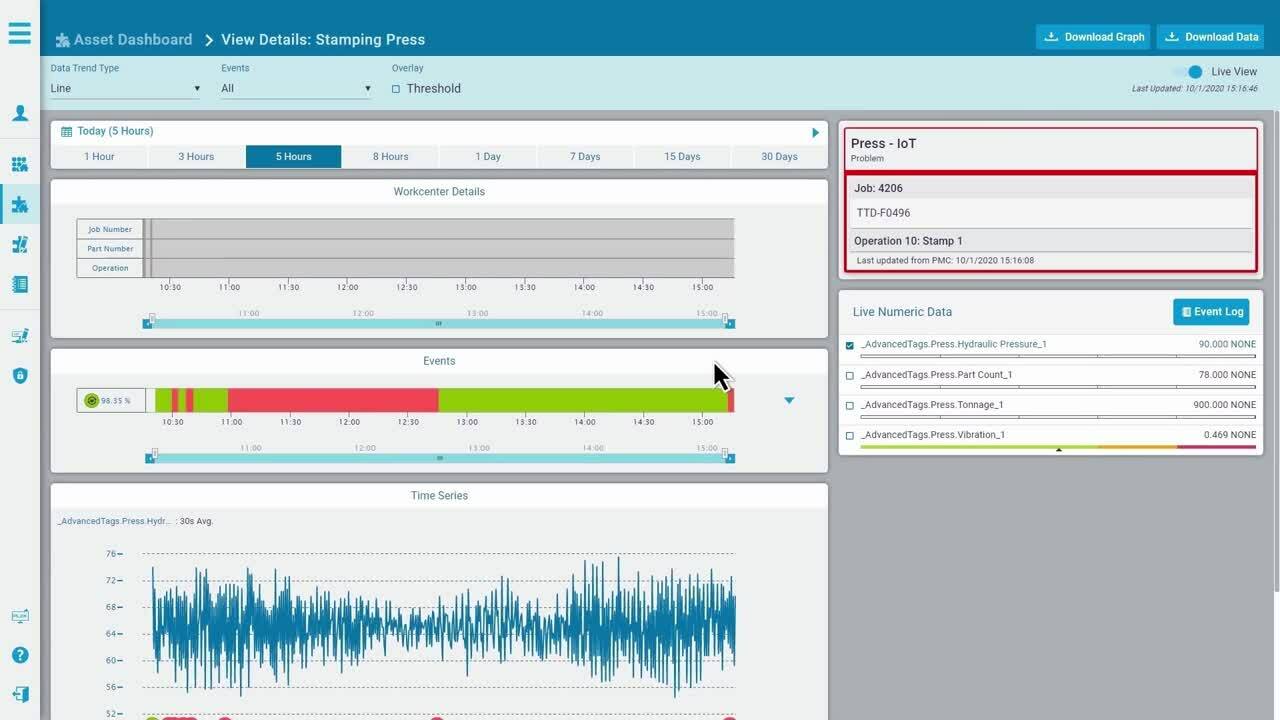
什么是两层erp?
Two-tier enterprise resource planning (ERP) is an increasingly common term used to describe how a multi-entity company maintains a legacy ERP system to manage the business operations and financials of the corporation at its headquarters (1st tier) but uses different ERP system(s) (2nd tier) at satellite divisions, subsidiaries, geographies or factories. The 2nd tier systems may be used to run all (or most) of the satellite and roll up consolidated financial and operational data to the corporate ERP backbone. In this scenario, the corporate ERP system is the system of record for the consolidated master data. While the top-tier ERP systems are typically installed at the corporate IT facility (known as on-premises), cloud-based software as a service (SaaS) solutions are being considered for the 2nd tier ERP.
Two-tier to Address Specific Factory Needs
遗留ERP解决方案可能是协调大型公司活动或巩固公司级信息(人力资源,财务等)的合适工具,但在解决迅速不断变化的运营级别需求或满足工厂级别要求时可能不会敏捷或有效。例如,遗留ERP系统经常做好巩固财务工作,但做出糟糕的工作(并且往往缺乏任何能力)管理任何厂房的生产活动,如跟踪库存实时,配套在线质量或采取帐户机器级测量和信息。
Two-tier ERP Scenarios
一种更具焦点的ERP解决方案,包括管理工厂所需的顶层HR和金融能力,但另外通过制造执行系统添加生产级别管理 - 或MES - 功能可能更好地适用于工厂级管理。换句话说,企业ERP解决方案(其中许多是通用的,而不是制造中心)通常不得管理工厂级所需的深度,同时以制造为中心的ERPS可以是对其企业弟兄们的完美恭维。
有任意数量的场景,双层ERP是右边的拟合,例如当旧版顶级系统运行正常但卫星需要注意。该公司可能已经对ERP进行了重大投资,并希望继续优化对核心业务的最小中断。但是,在卫星组织,维护合同可能会到期,或者版本如此过时,他们必须升级以保持运营。另一个常见的情景是一个严重定制的系统,需要太多的手动维护,可能已经超过了它的使用寿命。解决升级个人工厂以解决其独特需求的成本和精力可能会使最大的意义与安装大型顶级系统的实例。
A common scenario is when corporate headquarters are located in one country, while a second country has eight plants. Headquarters, which may not directly manage any plants at all, has the need to consolidate, analyze, and report on enterprise wide data, which the corporate ERP does well. The corporate ERP system, however, has limited or no capability to gather machine data, measure and manage real-time production data, or incorporate sensor-level data via industrial IoT (IIoT), a growing manufacturing capability. That corporate ERP was not made for the factory, and adapting it involves a lot of customization to add bolt-ons to accommodate plant-floor needs, and will still likely be a poorly connected system. Not to mention it was designed for top-floor ERP needs, not for plant-floor personnel, who often find these systems not user-friendly for their jobs at the plant level.
As mentioned earlier, the individual demands at multiple locations may be driving different requirements at the satellite organizations. For example, when acquiring a new subsidiary, it may be easier to satisfy regulatory requirements in its local country. A common scenario is that the acquired satellite has grown through acquisition itself and is already dealing with multiple ERP systems.

Rather than deal with the upgrades, integrations and business disruption of consolidating its own systems – or integrating into the parent’s – it may be a lower risk proposition to move to a cloud-based ERP solution that delivers a higher ROI and quicker time to value. This helps companies with standardization across the enterprise and enables more strategic decision making across production facilities.
Similarly, when spinning up a new satellite operation to meet a growing business need, implementing a cloud ERP system can reduce the financial risk to the new entity and perhaps even make them more attractive as a spin-off or for sale. “Next-shoring”, a new trend that actually plans for a finite life for a plant (depending on continued market conditions), benefits from this lower risk scenario and can be shut down if required without having to write down the capital expenses of computer hardware and software licenses (that may not be portable). Rather than implementing an unwieldy instance of the parent’s legacy ERP system, they can gain business advantage with a tool better suited for their specific needs and budget sensitivities.
There are many examples where “one size does not fit all” such as the specific needs required for compliance in different industries or geographies. Each country, industry and business-type combination may create a scenario that no one system could possibly satisfy and requires a custom configuration.
As has already been noted, the top-tier systems are too rigid and do not have the flexibility required for agile companies. Cloud ERP solutions, on the other hand, can be highly flexible and configurable in terms of capabilities, industry support and especially implementation. With a smart SaaS integration strategy, each satellite can have its own configuration “in the cloud” up and running in months and can roll up the necessary data to corporate without a hitch.
最后,虽然很少有公司想要取代他们的大型,昂贵且潜在定制的企业ERP实现,但第二层ERP解决方案提供的快速创新正在影响公司,以考虑在分区级别进行试验,然后与其他部门复制。随着云ERP的灵活性,具有整体的MES功能,这有助于提高整个公司的效率和生产力,而不会使企业ERP“AppleCart”扰乱。
“While today’s two-tier strategies mostly involve on-premises solutions, cloud-based solutions will gain favor over the next 18 to 24 months because of their rapid deployment capabilities, constant innovation qualities and subscription pricing. Whether SaaS, on-premises or hybrid, a two-tier ERP strategy will reduce costs, meet new business requirements and provide better business value.”
-Ray王,星座研究,“双层ERP部署的情况”
Increase Plant-level and Corporate Operational Efficiencies
Second-tier solutions can be a significant advantage, increasing operational efficiency at the satellite location while providing improved visibility to corporate. Cloud ERP solutions, specifically, are typically more flexible to the needs of smaller organizations or satellite locations and can be deployed much quicker with little or no disruption to the operating business. Significantly lower capital outlays and reduced IT burden make cloud an ideal choice for the 2nd tier ERP.
These benefits do not end at the second tier; the advantages at the corporate parent can be significant as well. Rather than investing in upgrades or customizations to their corporate system that are often required to support the specific needs of the satellites, they can focus their IT budget and resources at optimizing the “right tool for the right job” at corporate, supporting the satellites’ desire to do the same thing with tools better suited to their specific needs.

Agility with Reduced Investment Risk
188金宝搏登陆制造商需要更大的敏捷性,以越来越低的风险来扩展其业务。来自商业领导者的期望通常包括接管新地理位置和/或不同业务范围的收购(或剥夺)。例如,发展中国家为低成本资源和劳动力创造了巨大的机会;188bet体育然而,这种扩张可以在卫星组织强调典型的IT基础设施和小型IT团队。升级ERP系统 - 通常是较小的,目的构建甚至本土系统 - 所获取的公司的甚至是对来电组织的昂贵和破坏性。在此类收购期间降低投资风险的一种方法是实施第二层解决方案,这是一个更合适的卫星操作要求。
In addition, implementing large, legacy ERP systems at the divisional level is often cost prohibitive when compared to smaller, more nimble 2nd tier solutions, especially cloud-based solutions. In the case of on-premises implementations, license costs and ongoing annual maintenance (typically > 20 percent of the license fees), high-end servers and the skilled IT staff to manage it all creates a wall that many divisional leaders do not want to climb. Finally, expensive and lengthy implementation cycles that may take 6-12 months do not fit the needs of organizations that are facing challenging market conditions and higher expectations from their customers.
丛Delivers Corporate and Two-Tier ERP
Plex智能制造平台是仅用于专门针对世界各地客户和设施的制造商设计的云ERP和MES解决方案。188金宝搏登陆Plex在制造工厂提供了最终的ERP需求方面已经证明了成功,许多PLEX客户已经将他们的成功复制到多个工厂。
Cloud-based and SaaS solutions provide the best ROI for two-tier deployments, and modern web services make implementation much quicker and easier. In the Edge example above, the New York office, along with its Michigan and California facilities run Plex wall-to-wall. The subsidiary offices will consolidate under the New York entity. Then this division, along with its peer Mexico plant – as well as the Canada and China plants - will consolidate up into the Global Head Office. Once configured for the US operation, Plex can easily be replicated for the Mexico plant with a Spanish language overlay. The roll-up of financial data such as the general ledger and sales forecasts can be easily reconciled into the desired currency of the head office and be uploaded.
Plex特别适合上述卫星是制造设施的上述情景。最初旨在满足离散和流程制造商的需求,Plex通过无附加配置而定制了针对特定设施的需要量身定制的功能 - 不是定制的功能。188金宝搏登陆Plex专注于制造运营和开创性的纯Pullplay ME和云中完全集成的MES和ERP的独特要求。通过此SaaS模型,它可以快速提供较低的实现,并且其支持成本。
此外,丛提出使用“连续生长n” model where enhancements and upgrades are delivered continuously and does not suffer the obsolescence, or need for upgrade implementations typical of on-premise solutions. In this way, Plex is uniquely able to stay up to date with the changing needs of manufacturing businesses. This approach allows Plex to satisfy the unique requirements of manufacturing operations, such as:
- Real-time production ecosystem
丛MES delivers a real-time interoperable production system that guides, initiates and reports shop floor activities as they occur for optimized and responsive plant operations and processes. - End-to-end traceability
For every action in production, there is a transaction in Plex so every piece of inventory is tracked for precise genealogy and traceability such as to isolate and contain potential quality issues. - 闭环质量
Compliance with regulatory and quality standards is delivered through an integral quality control and checkpoint system in Plex MES, minimizing waste and ensuring standards compliance, documentation and traceability needs.
Plex客户往往是大型跨国公司,需要有针对性的系统简化和发展其运营。因此,Plex部署在制造工具中,以控制整个附属实体的操作,同时传达给父企业,作为经典的双层实现。Plex有许多以两层模式运行的客户。

Why Plex Now?
Built from the ground up for the cloud by manufacturing experts, Plex delivers the broad and deep ERP functionality that puts you ahead of the competition. The Plex Smart Manufacturing Platform is 100 percent focused on discrete and process manufacturing with industry-leading plant floor to top floor functionality. ERP and MES from Plex deliver unprecedented customer success through a relentless pursuit of continuous innovation for the manufacturing industry. The reason to choose Plex can be summed up by:
- 为制造商建造。188金宝搏登陆
With growth, manufacturers are faced with challenges to keep up with growing capacity. Because it was designed specifically for manufacturers, Plex more directly addresses the problems that modern manufacturers face. Plex allows you to drive operational efficiency by improving inventory accuracy, product quality and real-time reporting/analytics. - 操作的可见性。
As a complete, end-to-end solution for manufacturing businesses, Plex delivers a single, centrally managed source of manufacturing and business data. Connected from the top floor (business) all the way to work centers on the plant floor and all the way to the shop floor equipment itself, Plex ensures that data is collected at the “manufacturing moment.” This visibility makes traceability to specific data quick and easy and makes it simple to report and share across the enterprise. - Cloud Adoption.
The rapid increase in cloud adoption – especially in controlled ways such as functional or division level – makes deploying Plex at a plant level ideal. The lower IT overhead costs make spinning up a new plant easier and more cost effective with lower risk. Moreover, replicating a successful deployment to additional plants can be accomplished in weeks versus months.







